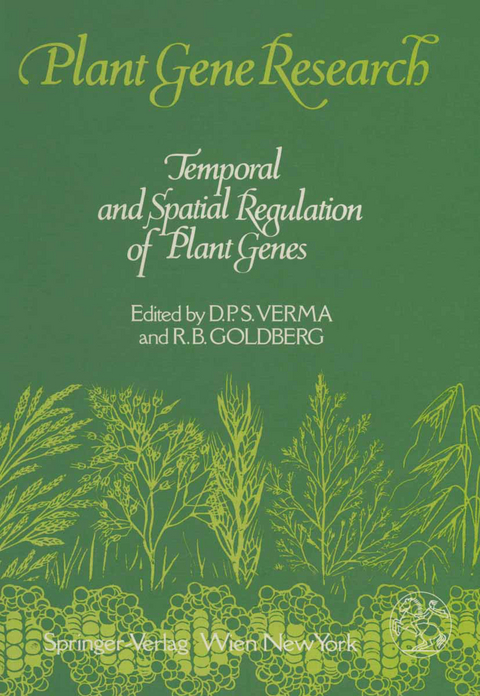
Temporal and Spatial Regulation of Plant Genes
Springer Wien (Verlag)
978-3-7091-7448-7 (ISBN)
1 Arabidopsis as a Tool for the Identification of Genes Involved in Plant Developmen.- I. Introduction.- II. Phytohormone Mutants.- III. Environmental Regulation of Growth and Development.- IV. Conclusions and Future Directions.- V. References.- 2 Regulation of Gene Expression During Seed Germination and Postgerminative Developmen.- I. Introduction.- II. Differential Gene Expression Underlies Seed Germination.- III. Spatial Regulation of Postgermination-Abundant Genes.- IV. Activation of Postgermination-Abundant Genes.- V. Future Directions.- VI. References.- 3 Genes Involved in the Patterns of Maize Leaf Cell Divisio.- I. Introduction.- II. The Shoot Apical Meristem as a Self-Regulating Unit.- III. Heterochrony.- IV. Maize Leaf Mesophyll and Epidermis Lineage Maps.- V. Leaf Vascularization and Development Compartments.- VI. The Importance of Periclinal Divisions.- VII. Strict Versus Loose Programming of Epidermal Cell Division.- VIII. Alternative Models Involving the Programming of Cell Division.- IX. The Ligule and Mutants that Affect It.- X. Kn 1: Neomorphic Mutants that Induce the Epidermis to Divide.- XI. Conclusions About Leaf and Ligule Development Derived from Mutant Analyses, and the Concept of Cell Age Identity.- XII. Where Are the Molecules.- XIII. References.- 4 Molecular Analysis of Genes Determining Spatial Patterns in Antirrhinum majus.- I. Introduction.- II. Cis-Acting Mutations.- III. Trans-Acting Mutations.- IV. Mutations Which Act Both in cis and trans.- V. Conclusions.- VI. References.- 5 Isolation of Differentially Expressed Genes from Tomato Flower.- I. Introduction.- II. Screening for Floral-Specific cDNAs.- III. Organ and Temporal Specificity of Floral Clones.- IV. Tissue Specificity of Floral Clones.- V. Discussion.- VI. References.- 6 Anther- and Pollen-Expressed Gene.- I. Introduction.- II. Gene Expression in the Anther.- III. Gene Expression in the Developing Male Gametophyte.- IV. References.- 7 Self-Incompatibility Genes in Flowering Plant.- I. Introduction.- II. Homomorphic Incompatibility.- III. Heteromorphic Incompatibility.- IV. Nature of the Self-Incompatibility Reaction.- V. Nature of the S-Gene Products.- VI. Studies of the Molecular Basis of Self-Incompatibility.- VII. Concluding Comments.- VIII. References.- 8 Regulatory Circuits of Light-Responsive Gene.- I. Introduction.- II. Multiplicity of Light Effects.- III. Effectors of Photoreception.- IV. Conclusions.- V. References.- 9 Regulation of Gene Expression by Ethylen.- I. Introduction.- II. Analysis of Ethylene-Inducible Gene Expression.- III. Discussion.- IV. References.- 10 Root Nodule Symbiosis: Nodulins and Nodulin Gene.- I. Introduction.- II. An Overview of Legume Nodulation.- III. Induction of Plant Genes Coding for Nodulins.- IV. Rapid Evolution of Legume-Rhizobium Symbiosis.- V. References.- 11 Structure and Expression of Plant Genes Encoding Pathogenesis-Related Protein.- I. Introduction.- II. Characteristics of PR mRNAs and Genes.- III. General Conclusion.- IV. References.- 12 Proteinase Inhibitor Gene Families: Tissue Specificity and Regulatio.- I. Introduction.- II. Developmentally Regulated Proteinase Inhibitor Genes in Seeds, Tubers, and Fruit.- III. Wound-Inducible Proteinase Inhibitor Genes in Leaves.- IV. Summary.- V. References.- 13 Cell Wall Extensin Gene.- I. Cell Walls.- II. Extensin Networks.- III. Extensin Genes.- IV. Prospects.- V. References.- 14 The Expression of Heat Shock Genes - A Model for Environmental Stress Respons.- I. Introduction.- II. Molecular Biology of Heat Shock Genes.- III. General Conclusions.- IV.References.- 15 Protein Transport in Plant Cell.- I. Introduction.- II. The Secretory Pathway.- III. Post-Translational Transport.- IV. Conclusions.- V. References.- 16 Genetic Engineering of Herbicide Resistance Gene.- I. Introduction.- II. Identification and Engineering of Herbicide Resistance Genes.- III. Conclusions.- IV. References.- 17 Virus Cross-Protection in Transgenic Plant.- I. Introduction.- II. Genetic Transformation to Produce Virus Resistant Plants.- III. Field Testing of Virus Protection in Transgenic Plants.- IV. Conclusions.- V. References.
| Erscheint lt. Verlag | 16.9.2011 |
|---|---|
| Reihe/Serie | Plant Gene Research |
| Zusatzinfo | XIII, 344 p. |
| Verlagsort | Vienna |
| Sprache | englisch |
| Maße | 170 x 244 mm |
| Gewicht | 627 g |
| Themenwelt | Naturwissenschaften ► Biologie ► Mikrobiologie / Immunologie |
| Naturwissenschaften ► Biologie ► Zellbiologie | |
| Schlagworte | Plant • Regulation |
| ISBN-10 | 3-7091-7448-1 / 3709174481 |
| ISBN-13 | 978-3-7091-7448-7 / 9783709174487 |
| Zustand | Neuware |
| Haben Sie eine Frage zum Produkt? |
aus dem Bereich


